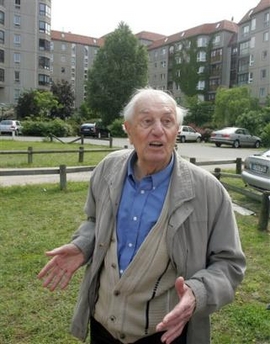The site of Hitler's bunker was marked publicly for the first time Thursday
by a historical group trying to demystify one of the Third Reich's most burdened
places.
The bunker's buried ruins lie below a parking lot, playground and adjacent
apartment building. The Berlin Underworlds Association unveiled its new marker ¡ª
a sign bearing graphics, photos and a chronology of events in both German and
English ¡ª at the edge of a sidewalk alongside the tree-dotted parking lot.

Rochus Misch, one of
Hitler's bodyguards throughout World War II, stands at the site of
Hitler's bunker, the 'Fuehrerbunker,' in Berlin, Thursday, June 8,
2006. [AP] |
"This is one of the most symbolic places in Berlin for the crimes the Nazis
committed, and we want to make sure people know the whole truth about it," said
Sven Felix Kellerhoff, an expert who works with the private group and wrote the
book "The Fuehrer Bunker: Hitler's Last Refuge."
Former SS Staff Sgt. Rochus Misch, a Hitler bodyguard throughout the war,
attended the unveiling and recalled his experiences.
"During the last 12 days of the war, I was down here with Hitler and the
other bodyguards all the time," said Misch, 88, pointing to the place where
Hitler killed himself on April 30, 1945, as Soviet troops closed in.
In an earlier interview with The Associated Press, Misch, one of the last
surviving witnesses of Hitler's final days, lamented that there was no
indication anymore of where the bunker was located in the heart of Berlin.
"History can be good or bad, but even if it's about a devil, people must be
informed of history," he said.
Berlin officials had been hesitant about pointing out the location because
they feared that neo-Nazis could turn the site into a place of pilgrimage.
But Kellerhoff said city guides often stop at the site of the bunker and tell
tourists myths about it, and that it was important to make the truth known. One
of the incorrect stories claims that the bunker had 12 floors and an underground
highway that Hitler used to cruise the city underground.
"That's all complete nonsense," said Kellerhoff, explaining that the bunker
built in 1935 contained several rooms and was fortified by walls nearly 14 feet
thick.
Hitler, 56, shot himself in the head inside the bunker located 30 feet
underground. Next to him was found his longtime mistress, Eva Braun, whom he had
wed two nights before and who committed suicide by taking cyanide.
Today, not much is left of the old bunker, which was attached to Hitler's
chancellery. After the war, Soviet soldiers blew up most of the bunker and in
the 1980s the remaining foundation and walls were filled with rubble, making it
inaccessible.
Under the East German government in the 1980s, the apartments were built and
the site was paved over.
The association conducts historical research and tours of Berlin's many
bunkers and tunnels.
Not everyone was happy with the idea of marking the spot, just a stone's
throw from the Holocaust Memorial down the block. Edna Hohenfeld, an Israeli
tour guide watching the unveiling ceremony, said the sign made her
uncomfortable.
"Why do they have to draw attention to this awful place? I am afraid that
neo-Nazis will now come here to celebrate Hitler," she
said.